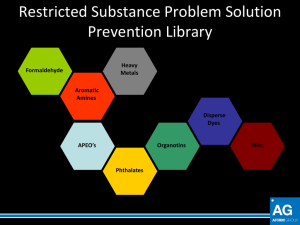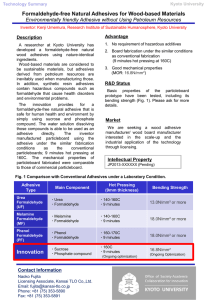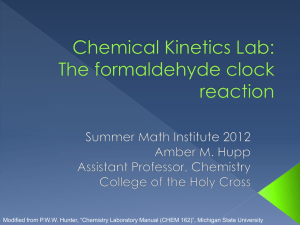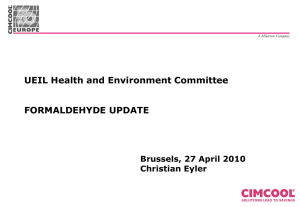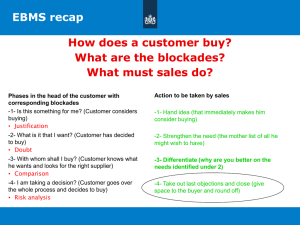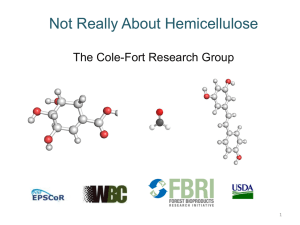Formaldehyde Problem #1
advertisement
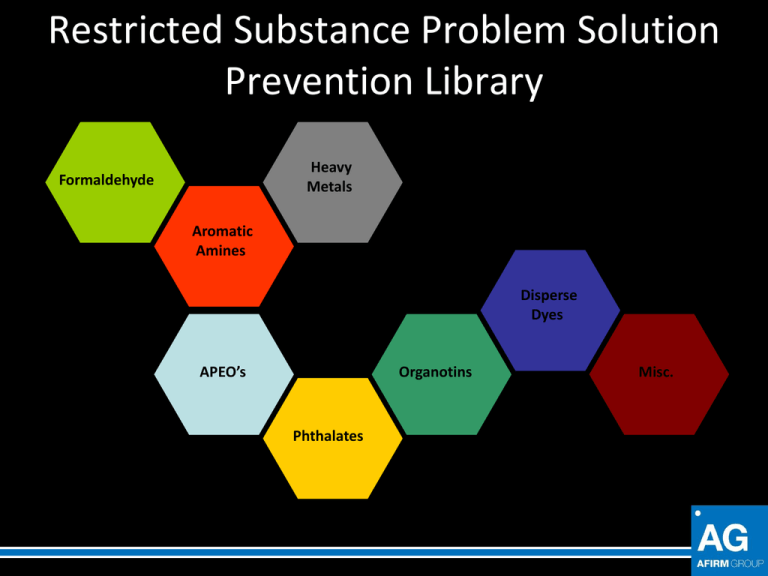
Restricted Substance Problem Solution Prevention Library Heavy Metals Formaldehyde Aromatic Amines Disperse Dyes APEO’s Organotins Phthalates Misc. Problem #1 • Soft hand screen print using discharge printing technique • Printer performed a strike off • Strike off approved for appearance • Printer could not meet formaldehyde requirements of the brand because the ink system used Zinc Formaldehyde Sulfoxylate (ZFS) catalyst Formaldehyde • Discharge ink systems require chemicals to break down the color of the dyed garment • Many discharge systems contain formaldehyde • Printer worked with ink supplier to optimize printing concentrations, curing times and temperatures • Reduced but did not remove 100% of formaldehyde in the final prints. • Product could not be used on children’s garments. Formaldehyde Problem #1 PREVENTION: Problem #1 • Printer developed a quality control process to manage print recipes • Curing times and temperatures kept consistent to meet RSL requirements for adult products • Printer looked for a non-formaldehyde catalyst system for discharge designs. • Printer and garment factory only show protos to brand that meet RSL requirements Formaldehyde Problem #2 • Urea formaldehyde resins are common chemicals used in durable press resins • Resins are used to prevent wrinkles and stiffen fabrics • Resin was applied to the backing fabric on the cap to maintain its shape • Backing fabric was less than 1% of the weight of the cap, but the amount of formaldehyde in the resin exceeded RSL limits by almost 200% Formaldehyde Problem #2 • Caps were not able to ship while solutions and alternatives were investigated • Some materials were washed to reduce the formaldehyde • Some other materials were replaced with alternatives • No process to control the formaldehyde could not be established • Developed a new material that would meet performance needs and RSL Formaldehyde the requirements. Problem #2 PREVENTION: • Low level formaldehyde failures were still common in the cap factories • Factory had not switched materials for all customers • Contamination from drying units and factory air handling units • Phase out of all formaldehyde containing chemicals was the only way to guarantee 100% compliance Formaldehyde Problem #3 • Urea formaldehyde resins are common chemicals used in durable press resins • Resins are used to trap wrinkles and stiffen fabrics • Cotton t-shirt designed by brand to have wrinkled effect by using durable press resin treatment • Garment had formaldehyde concentration above RSL limits Formaldehyde • Wrinkle finish had been cured for too short a time • Cure temperature was also too low • Process changes improved durability and RSL compliance • Always follow manufacturer guidance for process conditions • Always tell chemical supplier your compliance needs Formaldehyde Problem #3 PREVENTION: Problem #3 • In some cases a chemical on an RSL can be used • Conditions must be carefully controlled to manage finished product compliance • Work with high quality chemical suppliers • Always follow chemical supplier guidelines Formaldehyde Problem #4 • Formaldehyde releasing melamine resin is commonly used as a crosslinker in pigment printed garments and will cause formaldehyde failures • An alternative approach is to use a blocked diisocyanate crosslinker which is formaldehyde free • Isocyanates can be sensitizing and carginogenic so proper curing is required Formaldehyde Problem #4 • Diisocyanate crosslinker must be fully cured, used in correct ratios, and dried off • Printer will have to work with chemical supplier to develop proper conditions depending on equipment, temperature, and humidity • Measures must be taken to prevent occupational hazards when utilitizing diisocyanate crosslinkers Formaldehyde Problem #4 PREVENTION: • In this case chemical supplier provided formaldehyde free option because printer requested it, but printer did not ask if any new problems were created • ES&H must also be considered when utilizing new technologies • Work closely with suppliers, technical professionals, and laboratories when starting new techniques Formaldehyde Problem #5 • Cotton fabric failed Formaldehyde children’s Formaldehyde standard • Supplier knew that Formaldehyde was contained in the raw chemicals applied to the fabric • Supplier had worked with chemical supplier to control the concentration applied to meet Brand’s formaldehyde requirements Formaldehyde • Fabric supplier checked their production record and found out a typo in the batch formula which caused the formaldehyde concentration to exceed RS requirement • Supplier has changed their quality control procedures to review the formula before official production to avoid the same mistakes in the future. Formaldehyde Problem #5 PREVENTION: Problem #5 • The only 100% method to meet RS requirements is to eliminate the use of chemicals on an RSL • If a supplier knows they are using a chemical on an RSL they must establish and carefully monitor control procedures to ensure compliance • Supplier should also increase testing for affected products during development and production Formaldehyde Problem #6 • Formaldehyde was found in a Full Grain Leather material • Leather supplier initiated investigation and found out that Formaldehyde was used in one of the re-tanning chemical without any intended chemical function Formaldehyde • As a short-term solution, Leather supplier took strict measurement of decreasing the % usage of the Formaldehyde containing chemical in their formula to reduce Formaldehyde content level in their finished products • For long-team action, Leather supplier found a Formaldehyde free chemical to replace the contaminated chemical in their re-tanning process. Formaldehyde Problem #6 PREVENTION: Problem #6 • In some cases a chemical on an RSL can be used • Conditions must be carefully controlled to manage finished product compliance • Work with high quality chemical suppliers • Always follow chemical supplier guidelines • When possible search for formaldehyde free alternatives Formaldehyde Problem #1 • Brand designed a corded children’s sweater • Factory chose the cord supplier because it was considered a “standard” item • Cord supplier used a dyestuff that contained prohibited aromatic amines Aromatic Amines Problem #1 • Product was already manufactured so the only solution was an expensive decision not to sell the product • Lots of draw cords available to meet RSL • Dyestuff from quality chemical company with little to no cost impact Aromatic Amines Problem #1 PREVENTION: • RS requirements must be communicated to all suppliers • Laws require product compliance • A small component prevented the entire garment from being sold Aromatic Amines Problem #1 • Cadmium found in outer PVC (polyvinyl chloride) layer of soccer ball • PVC commonly contains heavy metal stabilizer • PVC also often contains phthalates for flexibili • Cadmium was used as a stabilizer • Cadmium can also be used in pigments Heavy Metals Problem #1 • PVC layer was substituted with a TPU (thermoplastic polyurethane) • TPU was tested to be RSL compliant • TPU had performed better for feel and durability Heavy Metals Problem #1 PREVENTION: • When investigating new materials or production techniques brands and suppliers have to work together to meet a variety of goals including: - price - performance - quality - safety Heavy Metals Problem #2 • Red paint used on trim of an infants shoe found to contain lead exceeding RSL limits. • Lead was used as a pigment in the paint • Lead is acutely toxic in high concentrations Heavy Metals Problem #2 • Brand voluntarily recalled product at a cost of $6.7 million • Factory began more complete testing program for sourced raw materials • Lead in raw material will still be lead in finished product Heavy Metals Problem #2 PREVENTION: • Source raw materials from reliable suppliers with a well controlled manufacturing process • Compliance of raw materials will lead to compliant finished products Heavy Metals Problem #3 • PU (polyurethane) coated fabric was found to contain high levels of lead • PVC and phthalates had been eliminated from the product • Lead could be used as a stabilizer or pigment • Not likely caused by contamination Heavy Metals Problem #3 • Brand gave RSL requirements to garment factory • Not all of the requirements were communicated to PU fabric vendor • Factory is expected to communicate RSL to their suppliers Heavy Metals Problem #3 PREVENTION: • Brands include all members of supply chain in RSL training • Garment factories must fully communicate all brand requirements to their downstream suppliers • Strategically test products at all stages of production Heavy Metals Problem #4 • Lead was detected in the coating on the top cover fabric of some sock liners • Heavy metals including lead are often used in low cost pigments and inks • Lead pigment was used in the heat transfer on the sock liner. Heavy Metals Problem #4 PREVENTION: • Brands include all members of supply chain in RSL training • Garment factories must fully communicate all brand requirements to their downstream suppliers • Consider even the smallest components in the RS compliance scenario • Strategically test products at all stages of production Heavy Metals Problem #5 • Chromium was detected on wool/nylon fabric • It appeared the mill had used a metalized dye • This same mill had already has the same problem before • Mill provided dye recipe and dye lot records and the recipe was not the problem • During mill audit brand reviewed dyes and auxiliary chemicals – all okay Heavy Metals PREVENTION: Problem #5 • Determined that mill had old stock of fabric that had failed previously • Mill had submitted wrong sample to laboratory for testing • Be aware of your inventory management systems • If all product is not RS compliant, provide clearly marked storage areas ***It is a best practice to produce only compliant materials in order to avoid contamination issues. Heavy Metals Problem #6 • Printed heat transfer failed for mercury • Mercury can be used as a pigment • In this case the source of the mercury was determined to be a cleaning solvent which contaminated a mixing beaker Heavy Metals PREVENTION: Problem #6 • Heat transfer supplier eliminated suspected cleaning agent • Changed their process to mix inks in disposable mixing containers • Established time frames for keeping custom mixed inks • Printer already had a separate mixing kitchen for this brand due to PVC requirements Heavy Metals Problem #1 • Many screen print inks contain PVC • PVC screen prink inks often contain phthalates • Phthalates are used to soften ink and prevent cracking • Printed t-shirts did not meet phthalate requirements for DEHP • All print chemicals were tested phthalate free prior to printing Phthalates Problem #1 • Spray adhesive used to hold garment in place during printing contained DEHP • Adhesive contaminated finished garment • Printer substituted a different spray adhesive to achieve compliance Phthalates Problem #1 PREVENTION: • Contamination is a big problem in RSL compliance • When developing a program think about everything that touches the product • The best approach is to make sure all raw materials meet the RSL requirements Phthalates Problem #2 • Plasticizers are commonly used in plastics and foams to increase flexibility and improve performance • Many phthalate based plasticizers have been banned as toxic or reproductive hazards • Manufactured claimed to use acetyltributylcitrate (ATBC) as plasticizer alternative in flip flop sandals • ATBC is considered a safer plasticizer alternative Phthalates Problem #2 • Consumer complaints that the flip flops had tacky feeling and were removing lacquer finish on wood floors • Laboratory analysis detected tributycitrate (TBC) instead of ATBC as manufacturer claimed • TBC is a known solvent for decoating furniture • Manufactured substituted TBC as a cheaper alternative for ATBC Phthalates PREVENTION: Problem #2 • Manufacturers must stick to recipes described to brands • Any substitutions should be approved by brand • Chemical substitutions should not be made on price alone without safety, quality, performance impact Phthalates Problem #1 • Scouring agent is used to remove oils and fats from textiles • Many scouring agents contain APEO’s (alkylphenol ethoxylates) as a surfactant • APEO’s will remain on the fabric after the scouring process APEO’s Problem #1 • Vendor chose scouring agent because it removed all oils for even dyeing • Vendor new it contained APEO’s • Vendor did not know brand was concerned about APEO’s on finished product • Vendor sourced an APEO free alternative scour agent with no cost increase APEO’s Problem #1 PREVENTION: • Communication • Alternatives exist for most restricted chemicals • Just ask for them APEO’s Problem #2 • APEO was detected in an insole board • Supplier investigated fibers used to produce the board and confirmed no APEO’s were used • Emulsion used to coat fiber board was contaminated with APEO’s • Supplier switched to a new batch of emulsion and component passed RS testing APEO’s PREVENTION: Problem #2 • Contamination is a big problem in RSL compliance • When developing a program think about everything that touches the product • Chemicals and tools must be properly handled, stored, and sanitized to prevent contamination. APEO’s Problem #3 • NPEO was detected in pig skin leather • NPEO is usually associated with the degreasing agents • Their previous source of degreasing agent is from Japan and known not to contain NPEO • A ban on raw materials exported from Japan forced them to change to an alternate source • NPEO source was identified as new degreasing agent. APEO’s PREVENTION: Problem #3 • When switching suppliers, for any reason, always share RS requirements with new supplier • A thorough RS testing program should focus testing on high risk items, unknown materials, or inexperienced suppliers APEO’s Problem #1 • Foil screen prints on children’s t-shirts found to contain organotins • Organotins are often used as heat stabilizers in printing and transfer processes • Organotins were found through testing of the foil backing adhesive Organotins Problem #1 • Print house had MSDS for all foil print papers and adhesives • All chemical suppliers were contacted to see if they used organotins • Some of the cheap adhesives contained organotins Organotins Problem #1 PREVENTION: • Communication • High quality adhesive chemicals should be requested • Non-organotin heat stabilizer alternatives are available Organotins Problem #1 • Phenol was detected in the adhesive used to manufacture shoes during a random audit • Chemical supplier believed that there was no Phenol in their adhesive • Supplier individually tested each of the chemical used to manufacture adhesive to detect for Phenol. Misc. • One of the chemicals used to produce adhesive had small residual of Phenol • Phenol used in the manufacturing but was supposed to be removed during processing • Supplier reviewed the chemical recovery process to ensure complete recovery of Phenol Misc. Problem #1 Problem #1 PREVENTION: • Establish routine testing procedure for presence of restricted substances in all process chemicals - Especially if a restricted chemical is a known precursor. Misc. Problem #2 • Molded black rubber logo failed on Polyaromatic Hydrocarbons (PAHs) • Rubber raw material supplier confirmed that one of the rubber raw materials, Naphthenic oil, contained PAHs Misc. • Rubber supplier reformulated material and substituted naphthenic oil out of formula • RS testing of the improved sample showed the new formula is RS compliant Misc. Problem #2 Problem #2 PREVENTION: • RS requirements must be communicated to all down stream suppliers • Down stream suppliers must understand RS requirements and impacts of raw material choices Misc. Problem #3 • PFOA was detected in a webbing (65% Polyester + 35% recycled PET) • Previous test of material met RS requirements • Supplier told brand that a non-wicking treatment had been applied to the material to provide water repellency since the last RS testing. Misc. • MSDS for the non-wicking chemical showed PFOA content and tests failed RS requirements • Supplier worked with the non-wicking additive supplier and replaced it with a nonwicking additive which is PFOS/PFOA free Misc. Problem #3 Problem #3 PREVENTION: • Review MSDS to see if any restricted chemicals are present, evaluate usage and process conditions *(MSDS will not include low percentage chemicals and chemical concentration in finished product will depend on chemical and application. MSDS should not be used to determine RS compliance.) • Alternatives exist for most restricted chemicals – ask for them Misc. Problem #4 • Small amount of Volatile Organic Compounds (VOC) was detected in the ink raw materials at screen print facility • Printer investigated and discovered contamination from solvent supplier recycling solvent tanks Misc. Problem #4 PREVENTION: • Chemicals and tools must be properly handled, stored, and sanitized to prevent contamination. • Know the contents of spot cleaners and other cleaners because they will be used in contact with finished products • Any chemical supplier to a facility must know the RS requirements to avoid contamination Misc. • Phenol was detected on silk fabric with a print during pre-production testing • By analysing individual raw materials the thickener (guar gum) was identified to be contaminated • Printer switched from guar gum to alginate thickener to avoid contamination problems Misc. Problem #5 Problem #5 PREVENTION: • Pre-production testing provided time to seek out alternatives and achieve chemical compliance Misc. • Black cotton / rayon socks were a high volume carryover item • No customer complaints for , until a cluster of 5 complaints for skin irritations within 1 month • Samples tested for pH, formaldehyde, restricted dyes – all tests negative • Samples pulled from store stock were noted to have a “solvent” smell Misc. Problem #6 Problem #6 • Socks were tested for VOC’s and found to contain Dimethylformamide, methylene chloride, and acetone • Supplier was found to be lubricating the knitting yarn with an unlabelled solvent with no MSDS information SOLUTION: • Production was stopped immediately • All current stock/shipments destroyed • Supplier is under review and production in their facility has been suspended • Supplier required to prove factory corrective action plan before production can resume Misc. Problem #1 • Restricted disperse dye was found in a woven label • All the yarns used to make this label were from well known suppliers and there was no history of RSL failure • Supplier tested all yarns used to make this label & no restricted disperse dye was detected Disperse Dyes • Only remaining component was the backer • Testing of the backer only produced a positive result for restricted disperse dye • Backer was changed and supplier destroyed all the inventory of failed backer color Disperse Dyes Problem #1 Problem #1 PREVENTION: • Laws require product compliance • A small component or part of a component can cause a product to be non-compliant Disperse Dyes Restricted Substance Problem Solution Prevention Library Heavy Metals Formaldehyde Aromatic Amines Disperse Dyes APEO’s Organotins Phthalates Misc.
